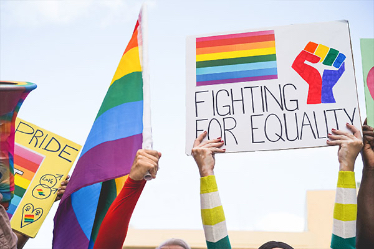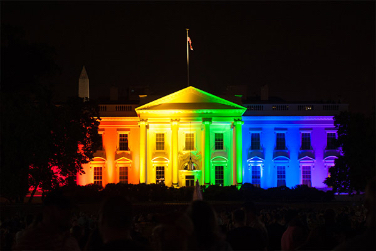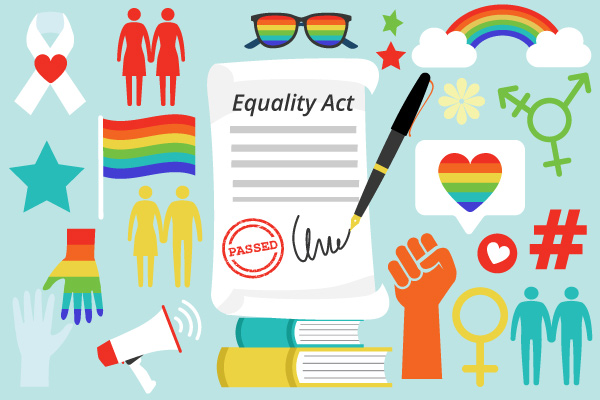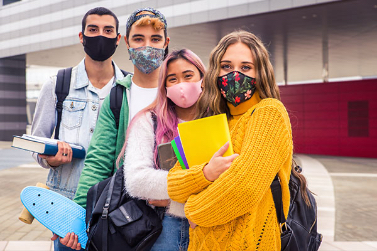
Hunger in the LGBTQIA+ Community
LGBTQIA+ individuals around the world have been suppressed for generations, simply because of who they love or how they express themselves. It is undeniable that the modern world has become far more accepting of the community and its members, but celebratory pride parades and rainbow flags don’t change the fact that LGBTQIA+ Americans are still facing so many obstacles, including an increased risk of experiencing hunger and homelessness.
Unfortunately, this situation is one that the LGBTQIA+ community is far too familiar with as 22% of LBGTQIA+ individuals live in poverty.
Food Assistance Programs
SNAP, or the Supplemental Nutrition Assistance Program, is a federal initiative designed to help hungry Americans put food on the table. As of November 2022, nearly 42 million people were enrolled in the program. LGBTQ+ people may make up a large percentage of those involved. According to the Center for American Progress, LGBTQ+ individuals receive SNAP benefits at twice the rate of non-LGBTQ+ people.
Despite the benefits that SNAP provides to millions of Americans, a proposal by the Trump administration limited the program’s assistance for people ages 18 to 49 without children. The change would have directly affected over 700,000 able-bodied Americans. Chief U.S. District Judge Beryl. A Howell of DC, however, struck down the attempt.
The U.S. Census Bureau concluded that 15% of same-sex couples were parenting at least one child in 2021, compared with 38.2% of opposite-sex couples. While it is four times more likely for a gay couple to adopt a child than a straight couple, it is not always easy or affordable for a same-sex couple to have a child. Adoption itself can cost anywhere between $15,000 to $40,000, while other methods like surrogacy and artificial insemination can range from $10,000 to over $100,000, according to the Family Equality Council.
While U.S. Secretary of Agriculture Sonny Perdue stressed that the SNAP change was made in order to discourage work-capable adults from relying on the government for assistance, the change may disproportionately affect LGBTQ+ adults. It is far less likely for an LGBTQ+ couple to have children due to the expenses, which means the SNAP change will affect these couples at a higher rate. In addition, it’s more difficult for them to find jobs. In fact, half of LGBTQIA+ adults reported experiencing some form of workplace discrimination or harassment in the past year because of their sexual orientation, gender identity, or intersex status.
In the second month of Biden’s presidency, on the other hand, he signed an executive order that allows restaurants to pay employees for preparing food to give to people struggling with hunger. His administration also extended the current 15% increase in SNAP benefits through September 2021. This move is expected to keep more than 40 million Americans from going hungry during the pandemic, including the able-bodied group that many LGBTQ+ individuals fall under.
LGTBQ+ DISCRIMINATION
In regards to the proposal by the Trump administration, “able-bodied” does not guarantee a job when it comes to members of the LGBTQ+ community. In 2023, 47% of LGBTQ+ adults lived in states where no laws existed to protect them from harassment, discrimination, or refusal of training in the workplace. Even today, it is estimated that nearly 50% of LGBTQ+ individuals remain closeted at work for fear of being treated differently or compromising professional connections, according to the National LGBTQ Workers Center. In addition to this, LGBTQ+ adults make up 6.2% of Americans who earn under $36,000 per year while only comprising 4.5% of the U.S. population.

Up until 2020, it was not rare for a worker to be fired or discriminated against on the basis of who they love and how they identify themselves. In 2018, 22% of LGBTQ+ workers were not paid or promoted at the same rate as their colleagues. The Supreme Court, however, made a historic decision in June of 2020 to expand the 1964 Civil Rights Act protections to lesbian, gay, and transgender workers. The 6-3 ruling was the result of a lawsuit filed by Gerald Bostock, an award-winning child welfare coordinator in Georgia who was fired after joining a gay softball league.
“Within months, I was fired for being gay,” Bostock told NPR. “I lost my livelihood. I lost my medical insurance, and I was recovering from prostate cancer at the time. It was devastating.”
Though the Supreme Court is the highest court in the United States, it is not the legislative body; this ruling does not have the power to prevent all kinds of discrimination against the LGBTQ+ community. Nondiscrimination laws vary by state, and many have no protections for discrimination in housing, credit, public accommodations, and more.
The House of Representatives, however, passed the Equality Act on Feb. 25, 2021, with a 224-206 vote. This bill would go farther than the Supreme Court ruling, as it would outlaw discrimination in more areas such as employment, education, jury service, housing, credit, and public accommodations.
The writer of the bill, Rhode Island Democrat David Cicilline, has introduced the bill every year since 2015. A version of the Equality Act was passed by the House of Representatives in 2019 but did not make it past the Senate. It is unknown as to when the Senate will vote on this bill, but President Biden stated that its passing is one of the top priorities during his first 100 days in office.
“The LGBTQ community has waited long enough,” Cicilline said to the members of the House. “The time has come to extend the blessings of liberty and equality to all Americans, regardless of who they are or who they love.”

The Equality Act, if it becomes law, would go a long way towards ensuring that the LGBTQ+ community is afforded the same treatment as others. Not only would this be a moral win, but it would help keep LGBTQ+ individuals from going hungry due to a current lack of educational and professional opportunities. President Biden told Philadelphia Gay News that it will ensure “no future president can ever again roll back civil rights and protections for LGBTQ+ individuals.”
The Equality Act has not yet been introduced in the current 118th Congress.
Still, there are certain worries that are specific to LGBTQ+ individuals struggling with hunger. Many food banks, especially in certain areas of the country, are religiously affiliated. While a straight or cisgender person in need doesn’t necessarily consider this a factor, members of the LGBTQ+ community face the possibility of being turned away.
A Williams Institute June 2020 study analyzed interviews with 93 low-income LGBTQ+ adults living in Los Angeles and Kern County, California. The study highlighted that many of the respondents worry about rejection from these kinds of food banks.
In fact, approximately 14% of LGBTQ+ individuals have avoided a faith-based food pantry at one point or another. Because of this, many hunger organizations have started projects to help. WhyHunger, a service used to connect people to food pantries near them, has over 32,000 locations in its database. Recently, they have added information about which places are safe and welcoming of the LGBTQ+ community.
Lorrie Clevenger, WhyHunger’s Director of US Programs, was a big part of this initiative. “We’re working on figuring out ways to identify places that would be safe for someone who identifies as LGBTQ to go and know that they’re not going to be turned away, or be treated in a way that is disrespectful,” she told Food Bank News.
LGBTQ+ Nondiscrimination Laws Across the U.S.
Click a state on the map below to view more information about its policies and laws.
The policy score of each state is dependent upon the extent of the existing nondiscrimination laws there. A higher score means that laws exist to protect individuals from discrimination based on sexual orientation or gender identity, whereas a negative score identifies the presence of discrimination laws that explicitly target individuals based on sexual orientation or gender identity.
Source: Movement Advancement Project
THE TRANSGENDER COMMUNITY
The most recent U.S. Transgender Survey (USTS) reported that a fifth of the transgender population (22%) was living in poverty. This is compared to 12% of the general population.
In addition, 30% of respondents reported being homeless at one point in their lifetime, and 27% responded that they had been fired, not hired, or not promoted in 2016 or 2017 because of their gender identity.
Though this survey relies on information gathered in 2015, the transgender community is facing more hate than ever. According to the Human Rights Campaign, more anti-transgender bills have been passed in 2021 thus far than ever before. ABC reported that 82 state bills have been introduced as of April 2021, compared to the 79 bills introduced in all of 2020.
Most of these bills focus on athletics and healthcare. A bill in the South Carolina House and Texas Senate would prohibit doctors from providing gender-affirming treatments to minors, and a Michigan Senate bill would prevent transgender high school students from participating on the sports teams that correspond with their gender identity. South Dakota and Mississippi have already passed similar bills.
While Mississippi Governor Tate Reeves tweeted that the act was passed in order to “ensure young girls are not forced to compete against biological males,” The American Civil Liberties Union (ACLU) of Mississippi disagrees. The organization believes the legislation is an attempt to “[erase] and [exclude] trans people from participation in all aspects of public life.”
A bill known as the Save Adolescents from Experimentation (SAFE) Act was under review in Arkansas. The state became the first in the country to pass a bill that prevents doctors from providing hormone treatment, puberty blockers, and transition surgeries to transgender youth, under the assumption that minors are too young to make decisions regarding transition-related care. Arkansas Governor Asa Hutchinson vetoed the bill on April 5, but state legislators voted to override the veto just one day later.
The governor did already sign two laws before the SAFE Act landed on his desk; one that bans transgender girls from playing on girls’ sports teams, and one that allows doctors to refuse non-life-threatening treatment to patients due to religious or moral disapproval.
Transgender youth are being pushed towards a lifetime of oppression, as they will carry the harmful opinions expressed by this legislature with them to adulthood. This type of discrimination is what leads to high levels of hunger and homelessness in the community, a risk that has only increased with the COVID-19 pandemic and the plethora of anti-transgender bills circulating in the U.S.
GENERATION Z AND GENDER IDENTITY
As the years go by and the world becomes more accepting, people are becoming increasingly free to be themselves without living in a binary world. According to a February 2021 Gallup poll, one in six Generation Z adults, or those born between 1997 and 2002, describe themselves as something other than heterosexual. This is nearly 16% of people ages 18 to 23. With this new data, the total number of LGBTQ+ adults in the U.S. increased from 4.5% to 7.1% since 2017.
As the chart shows, the number of people that come out as gay, lesbian, bisexual, transgender, queer, or anything in between is going to continue to increase. Gen Z is still young, with its youngest members at just nine years old. As these children continue to grow up in more loving, accepting environments, the LGBTQ+ community will inevitably expand.

While it is comforting and heartwarming to know that today’s children will feel free to be themselves, it also means that the issues of hunger and discrimination are not going to disappear. The LGBTQ+ individuals in this country are already predisposed to hunger and homelessness, and this fact is only exacerbated by the systemic discrimination that the community faces. It is not only seen in the workplace; it is seen in adoption agencies, in housing accommodations, in education, in the legislature, and in all other aspects of American life. As the community gets larger, so does the number of people affected by unfair treatment.
What Can You Do to Fight Against Food Insecurity in the LGBTQ+ Community?
We can’t expect things to change if we are not doing anything to change them. If you want to be an ally, stay educated on the topic of how hunger affects the LGBTQ+ community and also how they’re discriminated against. Read through how hunger disproportionately affects women and our hunger and homelessness page; and learn more about food waste in America, the impact of COVID-19, and how hunger affects America as a whole.
On top of that, there are also some amazing resources and organizations you can support. To support the transgender community, visit the National Center for Transgender Equality. GLSEN helps advocate for the LGBTQ+ community in K-12 education. The Center for Black Equity is leading the charge on promoting equality for the Black LGBTQ+ individuals, and the Movement Advancement Projects helps keep track of nondiscrimination laws in each state.
While the fight for equality in the LGBTQ+ community is vast, much of it starts with making sure everyone has enough food to eat. We all can pitch in to help those in need. Consider making a donation to Move For Hunger, or signing up to host a food drive or fundraiser.
